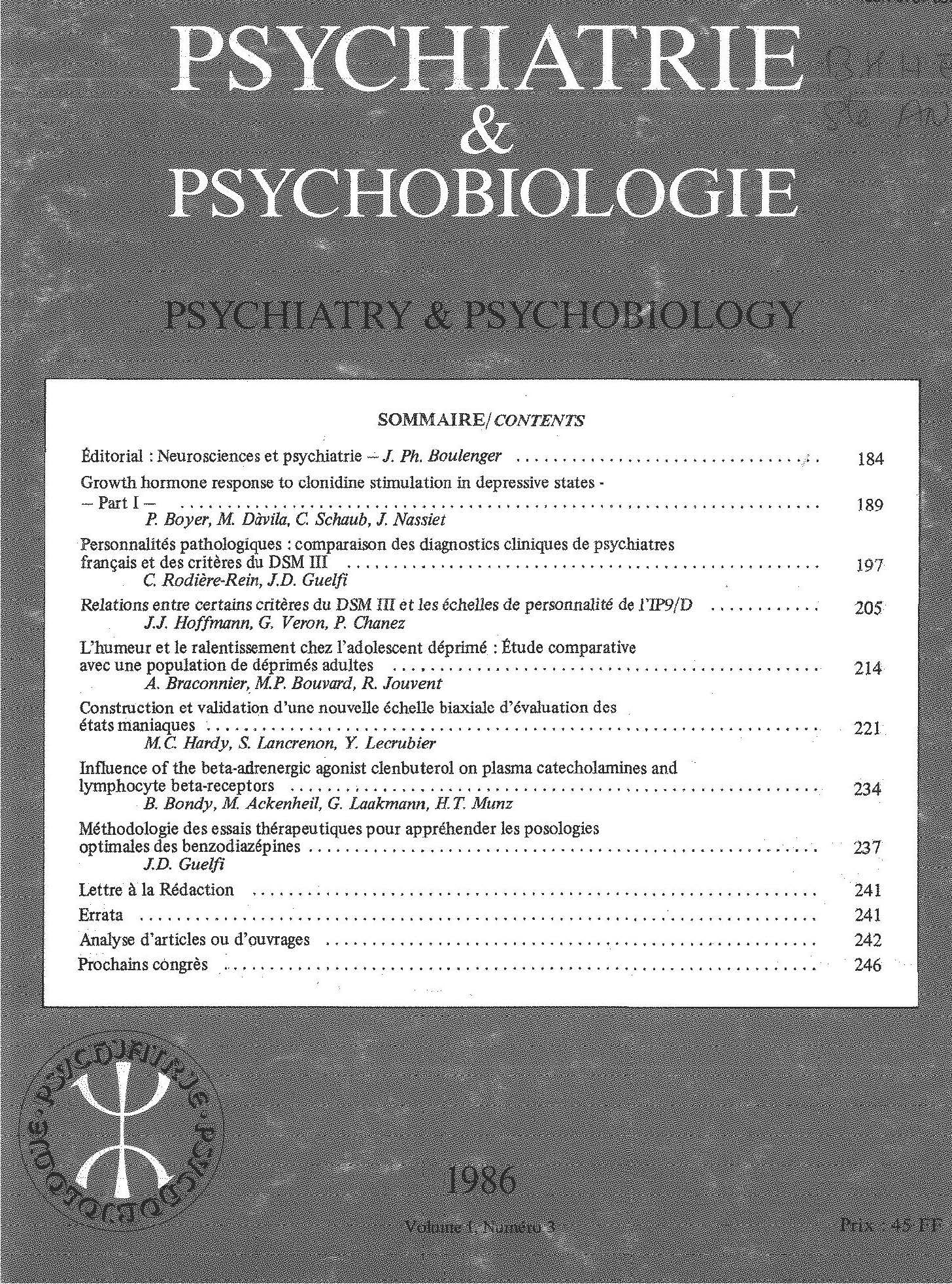No CrossRef data available.
Article contents
Différenciation des psychoses hallucinatoires chroniques et des psychoses dissociatives à partir du test de Rorschach
Published online by Cambridge University Press: 28 April 2020
Résumé
Depuis les travaux de G. Ballet, la psychose hallucinatoire chronique est un tableau clinique classique de la nosographie française. Ce trouble existe dans les pays anglo-saxons sous d'autres noms. Ainsi, la schizophrénie type paranoïde du DSM III-R correspond à notre description de la PHC. Le but de cette étude est d'apprécier l'existence d'une possible différence structurale entre PHC et les troubles schizophréniques caractérisés par la dissociation et les troubles du cours de la pensée.
Deux groupes de 14 sujets, appareillés selon le sexe, présentant soit une PHC soit un trouble schizophrénique selon les critères empiriques français ont été comparés par l'intermédiaire de la passation du test de personnalité de Rorschach.
L’analyse des résultats indique que le groupe des PHC présente un meilleur fonctionnement cognitif et surtout une Plus grande conservation des liens avec la réalité extérieure. Cette constatation se traduit dans le groupe des PHC par un pourcentage de bonnes formes (74,5%) identique à celui observé dans une population de sujets sains (75%), alors que ce même pourcentage est effondré dans le groupe des schizophrénies (52,1%). Par ailleurs, la comparaison des critères empiriques français et des critères diagnostiques du DSM III-R indique que les PHC correspondent, dans 8 cas sur 14, aux schizophrénies paranoïdes et, dans 6 cas sur 14, aux troubles schizo-affectifs.
Summary
Since the contribution of G. Ballet, chronic hallucinatory psychosis (PHC) has constituted a specific entity in French psychiatry. Auditory hallucinations alone or accompanied by delusions are the main feature of this disorder. Auditory hallucinations are either:
– simple hallucinations, speaking directly to the person;
– hallucinations consisting of a voice usually providing an ongoing commentary on the individual's behavior or thoughts; or a conversation between several voices, or the patient's thoughts being spoken aloud.
Delusional themes consist of the following: being controlled, thought broadcasting, thought insertion, persecutory or any other themes.
In addition, incoherence, marked loosening of associations are absent. The prognosis, particulary concerning psychosocial capacity, is better than in schizophrenia. This description points out some similarities between PHC and DSM III-R paranoid type schizophrenia.
The aim of this study is to compare the level of personality defense mechanism in PHC and in schizophrenia marked by incoherence and dissociation. Two groups of 14 patients, sex matched (Table I), and diagnosed according to French empirical criteria of PHC and schizophrenia have been compared using the Rorschach test. Furthermore Rorschach scores of each of these groups have been compared with those of healthy subjects (Student's t test). The two groups of patients were compared using Mann and Whitney U-test. Table II indicates that French PHC diagnosis is correlated with DSM III-R paranoid schizophrenia, but also with unipolar and bipolar schizoaffective disorders. Tables III and IV indicate the Rorschach score (a legend presents a brief summary of the scoring system).
Compared with schizophrenia, PHC patients have a low number of answers (R) but including a high percentage of popular responses (BAN), a high percentage of animal figures (A) and accuracy responses (F+ %). Furthermore, there is no significant difference between F+ % of healthy subjects and of patients with PHC (74.5). However, there is a significant difference between F+ % of healthy subjects (75%) and that of schizophrenic patients (52,1%). The achievement of accurate form indicates adequate reality testing which suggests a relatively secure defensive and adaptive position. PHC patients then present a relatively stable and well limited delusion mechanism which is in contrast with delusion mechanisms observed in schizophrenia.
These results suggest that French PHC or DSM III-R paranoid schizophrenia is unrelated to other types of schizophrenia. On the other hand, future research must investigate the links between paranoid disorder without dissociation and affective disorders.
Keywords
- Type
- Article original
- Information
- Copyright
- Copyright © European Psychiatric Association 1989



Comments
No Comments have been published for this article.